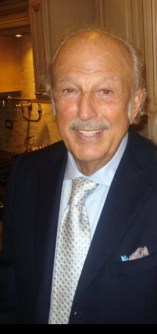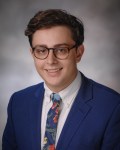Retired for more than 10 years now, Dr. B looks back with fondness at the three decades he spent at Fenwick.

Dr. Bostock and his wife in Sorrento, Italy.
DHow many years were you at Fenwick (and when)?
I was at Fenwick from 1979 until 2008: 29 years. When I arrived at the hallowed halls I thought I’d dropped into heaven (compared to the previous two years of my teaching life).
What was your role / what classes did you teach?
I was assigned to teach freshman English in ’79. Mr Duane Langenderfer (‘Derf’) and I shared the freshman English between us: four classes each in Room 1 with about 30 students in each class. The emphasis was on grammar, writing and English literature.
Much to my disappointment, the Head of the English Department assigned me to teach two sophomore and two senior classes the following year. I was disappointed because I’d had such a wonderful year I figured my ‘heaven’ would continue with freshmen. (Ah, man proposes and God disposes!)
From then until my retirement I was ‘stuck’ with two soph and two senior classes; those two latter eventually becoming two AP sections of English. However, for several years after Fr. Landmesser’s retirement I was Head of Department, so I can blame only myself for my schedule.
Were you involved with any extra-curricular activities? (If so, which ones?)
Meanwhile I was engaged in a variety of extra-curricular activities, the most bizarre of which was when I was asked to run the computer club for a year (in those days computers were few and far between; there were no computer labs in the school, and the so-called ‘club’ had one old Apple C and an old mainframe kind of machine that no one knew how to use. As for the moderator of the club, he/I was totally computer illiterate anyhow.) I think that was in 1985-86.
In ’79-’80 I was the moderator of the Debate Team, another area where I was ‘somewhat’ competent.
Fortunately, Dan O’Brien, Master i/c Athletics and Sports, invited me to start a soccer program in ’81. And my extra-curricular career took off! Much to the chagrin of the head of cross-country, [as] almost all his runners opted to play soccer. So Fenwick had a varsity soccer team; we didn’t belong to the Catholic League, so all our games were ‘friendlies.’ We tied one game and lost all the others. But we had fun. In year two a volleyball coach was assigned to help me with the program, and we joined the League. I think we won one game and tied another, so we made huge progress.
Then Fr. Bernacki allowed me to give up extra-curriculars so I could write a dissertation for my PhD (Fordham University had informed me that I had to write a diss or ‘get lost.’ So I wrote.) Thereafter (’82 thru 2008) I became a jack of all trades: back to frosh soccer for a while, several years moderating the year book, several the student newspaper, and finally girls’ frosh soccer. To say I had a blast would be an understatement. The many girls and boys with whom I was lucky enough to come in contact graced my life in ways that they will never know. But I thank God and Fenwick for the privilege of having been with them and known them.
For a couple of years in the early ’80’s I organized the Easter UK literary jaunt, staying in London, Bath and Banbury. A good time was had by all. And I hope we appreciated the historical and literary sights and sites.
How do you describe the Fenwick Community to other people?
Talking with others, including former students, Friars I meet who were at Fenwick years before I arrived, I always mention the ‘aura’ of the place. It’s the feeling that the Dominican Order, the teachers, the students and the parents have created over the years. It’s not simply one element. It’s an awareness that all at Fenwick have: we may not be able to pin it down in words, but it’s a kind of excellence of spirit — intellectual, athletic and spiritual.
What do you miss (most) about Fenwick?
I miss learning; MY learning. I learned much from my students. A small example: one day we were reading Hamlet in class, the students taking the actors’ parts. A female student reading the part of Gertrude emphasized a line of her speech in a way that shed a completely new light on Gertrude’s character. It was an insight I had not witnessed in any of the famous dramatizations I’d ever seen (not even in the play directed by Derek Jacobi and starring Kenneth Branagh in the title role that I saw in Manchester; Jacobi was in the audience four seats to my left). I forget the name of the student, I forget the line, but I have never forgotten the experience.
I also miss reading English literature. In 10 years of retirement I find that I’ve taken to reading a lot of science and mathematics: The Calculus Diaries, Fermat’s Last Theorem, Six Easy Pieces, In Search of Schrodinger’s Cat, The Fly in the Cathedral, The Emperor’s New Mind, etc. I’ve just gone where my interests have taken me, and I suppose after 49 years of reading ‘literature’ my mind needed a break from poetry and fiction. But I do miss Keats, and Chaucer, and Bill.
Funniest Fenwick moment?
I was coaching the frosh girls’ soccer team at the Priory. The field was sodden, it was raining and I attempted to show the players how to chip the ball. Only wearing smooth sneakers, I took a quick run at the ball and landed flat on my back in the mud. Girls rushed forward to ask ‘Are you okay, coach?’ Of course I was okay. But later going over the incident in my mind, I thought, ‘If that had been the frosh boys’ soccer team, they’d have stood there giggling at me.’
Fondest Fenwick moment?
At the final Commencement in 2008 when Dr. Quaid announced my retirement, the whole senior graduating class rose to their feet applauding. Sitting among them, I was shocked, amazed, surprised, flabbergasted, not to say embarrassed. But it was a fine feeling to be honored thus.
Do you have any words of wisdom for current students?
Carpe diem, quam minimum credula postero = “Be the best you can be;” all the rest is fruh.
Any wise words or advice for the present faculty, staff or administration?
Far be it from me to preach, but … teaching is the process of opening minds, not (force) feeding them.
And Fenwick is a Christian institution, so follow Christ’s rules: Love God and love your neighbo(u)r. Period. Shibboleths from the Old Testament should have no part in a Christian community.
What are you doing now? How do you spend your time?
Continue reading “Catching Up with Former English Teacher Peter Bostock”


















 Editor’s Note: 2018 Fenwick graduate Nick Bohlsen, of Oak Park, is finishing his freshman year at DePaul University in Chicago. Bohlsen wrote this paper last semester for his “Writing Rhetoric and Discourse 103” class, earning an “A” for his effort. (A Networking Infrastructure 263 course also used a more detailed version of this report.)
Editor’s Note: 2018 Fenwick graduate Nick Bohlsen, of Oak Park, is finishing his freshman year at DePaul University in Chicago. Bohlsen wrote this paper last semester for his “Writing Rhetoric and Discourse 103” class, earning an “A” for his effort. (A Networking Infrastructure 263 course also used a more detailed version of this report.)

 Internet ad delivery is a complex process involving multiple redirections, synchronizations of user information and an auction, all in a few tens of milliseconds. (Wicker & Karlsson, 70)
Internet ad delivery is a complex process involving multiple redirections, synchronizations of user information and an auction, all in a few tens of milliseconds. (Wicker & Karlsson, 70)


 “The idea is to develop a playlist for a main character, and I chose Sydney Carton from A Tale of Two Cities,” Magrady explains. The next day, she asked her English II College Prep students to do the same. The assignment took off running.
“The idea is to develop a playlist for a main character, and I chose Sydney Carton from A Tale of Two Cities,” Magrady explains. The next day, she asked her English II College Prep students to do the same. The assignment took off running.
 Throughout the course of 90 school years, Fenwick High School has seen its fair share of high-achieving scouts pass through its storied doors. Earning the Boy Scouts’ distinction of Eagle Scout or receiving the Girl Scouts’ Gold Award are akin to graduating as a Friar: They are highly significant accomplishments that, quite frankly,
Throughout the course of 90 school years, Fenwick High School has seen its fair share of high-achieving scouts pass through its storied doors. Earning the Boy Scouts’ distinction of Eagle Scout or receiving the Girl Scouts’ Gold Award are akin to graduating as a Friar: They are highly significant accomplishments that, quite frankly, 






 Gold Award recipients also have a competitive edge in the college admissions process and are eligible for
Gold Award recipients also have a competitive edge in the college admissions process and are eligible for 








 He is one of only 23 coaches to win a Super Bowl with more than one team: two back to back with the Denver Broncos (1997 and 1998) in the John Elway era and one with the Indianapolis Colts (2006) in the Peyton Manning era. (“Sorry, Bears fans,” jokes Teerlinck, whose family moved when he was eight years old from upstate New York to suburban LaGrange Park, IL.)
He is one of only 23 coaches to win a Super Bowl with more than one team: two back to back with the Denver Broncos (1997 and 1998) in the John Elway era and one with the Indianapolis Colts (2006) in the Peyton Manning era. (“Sorry, Bears fans,” jokes Teerlinck, whose family moved when he was eight years old from upstate New York to suburban LaGrange Park, IL.)

 When he played defensive line for Fenwick in the 1967 and ’68 seasons, the Fighting Friars’ varsity went a combined 10-5. After a 7-2 junior campaign, a 3-5 record as a senior was disappointing. The defensive unit gave up a respectable 15.5 points per game (ppg) in the autumn of 1968. However, an anemic offense could muster only nine touchdowns all year for a paltry average of 7.25 ppg. Teerlinck was an All-Conference selection and went on to become an All-American for the Western Illinois University (Macomb, IL) Leathernecks. “We used to get New York Giants games at Western and I’d watch No. 89, Fred Dryer, and copy his moves,” Teerlinck told Chicago Tribune writer Don Pierson in a
When he played defensive line for Fenwick in the 1967 and ’68 seasons, the Fighting Friars’ varsity went a combined 10-5. After a 7-2 junior campaign, a 3-5 record as a senior was disappointing. The defensive unit gave up a respectable 15.5 points per game (ppg) in the autumn of 1968. However, an anemic offense could muster only nine touchdowns all year for a paltry average of 7.25 ppg. Teerlinck was an All-Conference selection and went on to become an All-American for the Western Illinois University (Macomb, IL) Leathernecks. “We used to get New York Giants games at Western and I’d watch No. 89, Fred Dryer, and copy his moves,” Teerlinck told Chicago Tribune writer Don Pierson in a 







 VIDEO:
VIDEO: 






























